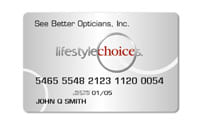
This OLA article discusses why it's time
to help your patients finance their eyewear purchases, and how a new program can
help you do just that
By Alex Yoho, ABOM
Why is it, in this industry, we are always comparing eyewear sales to shoes? Maybe it's because shoes outsell eyewear more than six to one, and we'd like to increase our action to match that of footwear. Sure, we have a product that has tremendous value to the consumer, but shoes are so fun and easy to buy. This is the point in the article where the old phonograph needle slides across the album and in the new silence you hear a shout of, "Wait a minute, did you say easy to buy?" Why, yes I did!
Perhaps it's time for the eyecare industry to learn a few more things from the business world in general. First of all, we in the eyecare industry have a unique product. All-in-one, we provide a medical device, a fashion accessory, a safety device, and several practical solutions to the vagaries of life. This is an exotic product, tailor-made for the individual consumer with many potential variations. The exotic and many variations part is like shoes, but we don't stop there. We go light-years beyond just fashion, yet we are having a dickens of a time making a buck.
So what is keeping us from cashing in on the wonderful products and services we sell? Some will undoubtedly say it's the economy, and though there's some truth to that, the vast majority of Americans are able to get both what they need and what they want. In reality, the number-one thing that prevents our customers and patients from spending their hard-earned money with us is that, unlike every other industry you can imagine, we haven't made it easy.
We've done it all--everything from top-down presentations to package deals and lifestyle dispensing--to make sure our patients know all the options and the benefits of those options. Some of us have the ability to get patients absolutely giddy about all the possibilities we can offer them.
Our patients are warmly received with a greeting at the door, handed off to the frame stylist by the doctor, who, of course, has done a wonderful job reviewing the options. Everything is done right, yet when it comes down to the point about cost, the patient balks. What have we done wrong?
The simple truth is eyecare professionals generally have had little formal training in how to run a competitive retail business--yet a retail business is exactly what we are in. Now, enter the consumer who is very informed. Products are smart, and consumers are extremely smart. Yet, we look for ways to dumb things down, thinking the consumer is ignorant and cannot possibly comprehend what they need.
|
|
|
|
The Lifestyle Choices Plan provides a financing option for optical patients that is reminiscent of many retail outlets' credit options |
|
MAKING IT EASY
Have you ever asked yourself why the same people who balk at the price of eyewear willingly spring for high-speed Internet service, stop at the coffee shop twice a day, and splurge on that new laptop or MP3 player with out batting an eye? Because it's easy.
So we'll make buying eyewear as easy as making those other investments. It's called the "Lifestyle Choices Plan," and OLA labs will be introducing the eyewear flexible financing program early this year.
Financing is not new. Orthodontists have been involved for years, and some estimates suggest that already 70 percent of LASIK procedures are financed as well.
Why? Because doctors have found that when you begin by telling the patient that LASIK can be done for payments as low as $67 a month, patients definitely listen--which is why more and more ophthalmologists are increasingly working with financing companies that make small, short-term loans.
As presented to members labs at the OLA annual meeting in Indianapolis, here's how the Lifestyle Choices Plan will work: The office staff provides a credit application to the patient and faxes or e-mails it to the consumer financing company for approval. Then, after the approved sale is closed, the office staff forwards the completed transaction form to the financing company.
The Lifestyle Choices Plan is the brainchild of Pittsburgh-based Streamline Communications--a partnership among Margaret (Peggy) Hynes and Tim Fortner, both optical industry veterans whose careers include several years of marketing with Transitions, and Sam Sandora, who brings additional artistic and marketing expertise from outside the industry to the group.
FOOD FOR THOUGHT
Following is some of the food for thought raised by the Streamline Communications folks about why the time is right for this new, patient-friendly program.
Dispensing. ECPs need to embrace their role as a CEO and look at their practice as a business, because for most of them 60 percent of that business comes from the retail side.
Competition. Time was when the independent three Os had more than 50 percent of the marketshare. It's been slowly drifting to a savvy retail segment that uses such tools as consumer psychologists and even sensors in the floor that track which isle the consumer goes down first and how much time is spent in various shop locations.
Today, we have the smartest competition we've ever faced.
Technology. We also have the smartest technology we've ever had. People have come to expect this convenient technology in all aspects of their lives.
Needs. There are two driving forces in the marketplace: Price and differentiation. Consumers want a great treat or a great price, yet too many in our industry are trying to find middle ground between the two and are getting beat up.
Behavior. Your competition understands consumer behavior. For example, when people enter a store they look to the left and shop to the right.
They understand that people react negatively to prices ending in 0, 5, or 9, and positively to numbers ending in 7, 3, or 6. They know that the things to pay attention to are: A clean and inviting premises; good parking; merchandising with the age factor in mind; and an uncrowded space.
Custom goods. On average, people are willing to pay 20 percent more for custom-made products. We have the ultimate customized product, and this is what lifestyle dispensing is all about.
We've been talking lifestyle dispensing for 25 years, but we cannot create lifestyle dispensing until we give them lifestyle choices. What's missing? It's a plan that makes these products and benefits affordable.
Is this the wave of the future? You won't have to lower your prices because price is not the issue, cash is. You can offer your patients a line of credit, and since patients receive a card with your business name on it, your name recognition will increase every time they open their wallets.
|
A pay-per-month society |
Streamline Communications' Tim Fortner says, "You can't do lump-sum business on big-ticket items in a pay-per-month society." In other words, explains Fortner, eyeglasses aren't just a great healthcare value, but something that is the first thing people put on in the morning and the last thing they take off at night. And, they wear them seven days a week. Yet the consumer places little value on their eyewear. If they stop at the coffee shop every day on the way to work, they will spend twice as much on coffee over the course of two years than they paid for eyewear. Almost everything you could name that people spend their money on over the course of two years will be much more than they are spending on eyewear. Why? Because they pay for these things over a period of time, and none of them are paid in lump sum. That's why you can't do lump-sum business on big-ticket items in a pay-per-month society, concludes Fortner. Not when people wake up in the morning in a house they pay for by the month; go to a closet where they have 12 times more shoes than they do eyeglasses (most of which, they bought on a revolving charge account); turn on a TV with cable that they pay for by the month; then check their e-mail on the Internet service they pay for by the month; get into a car they pay for by the month; turn on a cell phone they pay for by the month; stop and get gas that is paid for by the month, etc. But, when they come for eyewear, we say "I'm sorry we don't work that way, we require payment in full." So, why, asks Fortner, are we only selling .48 pair of glasses every two years? Because we have not grasped what retailers already know: When you get to a higher-ticket item you have to offer flexible payments. Price is not the issue--cash is. |




